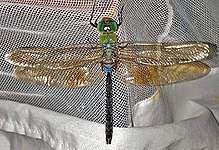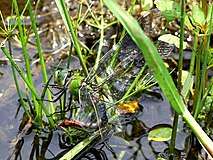Anax guttatus
Anax guttatus,[4] the pale-spotted emperor or lesser green emperor, is a dragonfly of the family Aeshnidae.[5]
| Pale-spotted emperor | |
|---|---|
 | |
| Anax guttatus from French Polynesia. Male | |
| Scientific classification | |
| Kingdom: | Animalia |
| Phylum: | Arthropoda |
| Class: | Insecta |
| Order: | Odonata |
| Infraorder: | Anisoptera |
| Family: | Aeshnidae |
| Genus: | Anax |
| Species: | A. guttatus |
| Binomial name | |
| Anax guttatus (Burmeister, 1839)[2] | |
 | |
| Synonyms[3] | |
|
List
| |
Distribution
Anax guttatus is widespread from India to Japan and Australia and Pacific Ocean Islands.[6] It is found in Northern Australia, Africa, Bangladesh, China (Guangdong, Guangxi, Hong Kong, Hainan), Indonesia, India, Japan, Maldives, Sri Lanka, Myanmar, Malaysia, Philippines, Peninsular Malaysia, Singapore, Thailand, Taiwan, Vietnam, Cook Islands, Fiji, French Polynesia, Marshall Islands, Micronesia, New Caledonia, Palau, Papua New Guinea, Samoa, Seychelles, Tonga and Vanuatu.[1][7][8]
Habitat
This species mainly occurs in open ponds, but also in various habitats, especially with slowly flowing or standing freshwater. It is also present in urban areas.[1]
Description
It is a big dragonfly with blue eyes, pale green thorax and dark brown abdomen with bright blue-green markings on the sides. It can reach a wingspan of about 11 centimetres (4.3 in) and a body length of about 8 centimetres (3.1 in). Forewings are clear, the inner-half of the hindwings is brown, while the outer-half is clear. Segment 1 and sides of segment 2 of the abdomen are pale green. The dorsum of segment 2 is blue. Segment 3 is pale green on the sides with a triangular blue spot on the dorsum. Segments 4 to 7 are with a pair of baso-lateral, postjugal, and apical spots, all in bright orange. The number of spots are lesser in segment 8 to 10. Anal appendages are dark brown; the middle of the inner margins of the superiors have a projection like a straight edged shelf. Females is similar to the male; but the brown patch on the hind-wing may pale or absent. The blue on the dorsum of segment 2 will be broken up into four by a narrow brown mid-dorsal carina and a transverse line lying midway to form a cross like mark. Anal appendages are very broad and shaped like lance head.[9][10][11]
 Male
Male Female
Female In flight
In flight.jpg) Female. Museum specimen
Female. Museum specimen.jpg) Dorsal view of the right wings of a male
Dorsal view of the right wings of a male
See also
- List of odonates of India
- List of Odonata species of Australia
- List of odonata of Kerala
Bibliography
- Fraser, F. C. (1922) Indian dragonflies. Part XIV., Journal Bombay Natural History Society 28 (4): 899-910, figs. 1-3.
- Lieftinck, M.A. 1954. Handlist of Malaysian Odonata. A catalogue of the dragonflies of the Malay Peninsula, Sumatra, Java and Borneo, including the adjacent small islands. Treubia 22(Supplement): i-xiii 1-202
- Rambur, P. (1842) Histoire naturelle des insectes. Névroptères., Librairie Encyclopédique de Roret, Paris 1-534, incl. pl. 1-12.
- Watson, J.A.L. 1973. Odonata (Dragonflies). Appendix 3 pp. 1–7 fig. 1 tables 1–4 in, Alligator Rivers Region Environmental Fact-Finding Study: Entomology. Canberra : CSIRO, Division of Entomology.
- Wise, 1980: Records of South Pacific Dragonflies (Hexapoda: Odonata). Rec. Auckland Inst. Mus. 17:175-178, W&D79,
References
| Wikimedia Commons has media related to Anax guttatus. |
- Dow, R.A. (2017). "Anax guttatus". IUCN Red List of Threatened Species. 2017: e.T167337A48635356. doi:10.2305/IUCN.UK.2017-1.RLTS.T167337A48635356.en.
- Burmeister, Hermann (1839). Handbuch der Entomologie (in Latin and German). 2. Berlin: T.C.F. Enslin. pp. 805–862 [840] – via Biodiversity Heritage Library.
- Biolib
- Martin Schorr; Dennis Paulson. "World Odonata List". University of Puget Sound. Retrieved 12 Oct 2018.
- Catalogue of life
- K.A., Subramanian; K.G., Emiliyamma; R., Babu; C., Radhakrishnan; S.S., Talmale (2018). Atlas of Odonata (Insecta) of the Western Ghats, India. Zoological Survey of India. pp. 187–188. ISBN 9788181714954.
- "Species Anax guttatus (Burmeister, 1839)". Australian Faunal Directory. Australian Biological Resources Study. 2013. Retrieved 28 January 2017.
- Query Results Archived December 15, 2007, at the Wayback Machine
- Cook Islands Biodiversity Database
- Watson, J.A.L.; Theischinger, G.; Abbey, H.M. (1991). The Australian Dragonflies: A Guide to the Identification, Distributions and Habitats of Australian Odonata. Melbourne: CSIRO. ISBN 0643051368.
- C FC Lt. Fraser (1936). The Fauna of British India, including Ceylon and Burma, Odonata Vol. III. Red Lion Court, Fleet Street, London: Taylor and Francis. pp. 140–142.
